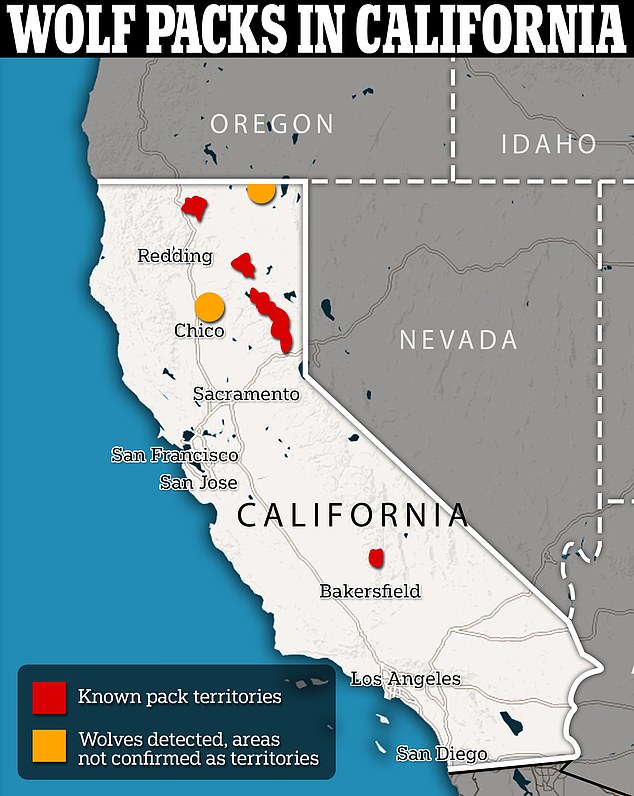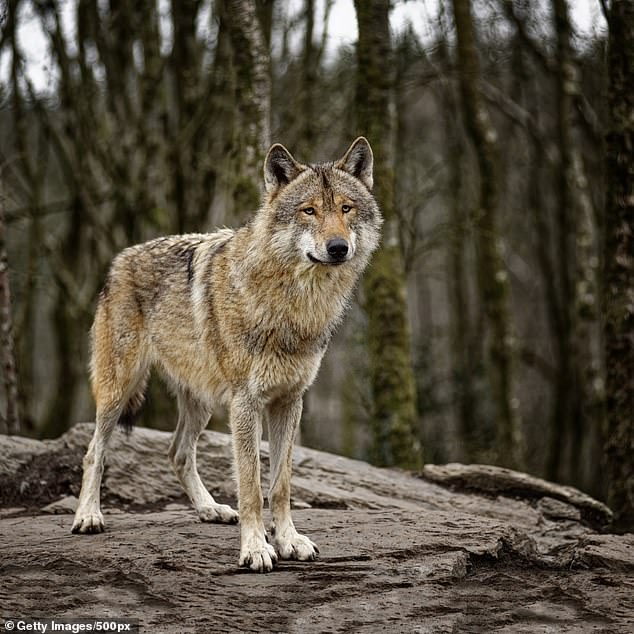California’s controversial rare beast that vanished over 100 years ago stages shocking comeback: ‘We’ve been invaded’
An endangered predator has returned to California after disappearing more than 100 years ago.
At least 44 gray wolves have been spotted on the state’s West Coast, including a record 30 new cubs this year alone, according to Axel Hunnicutt, gray wolf control coordinator for the California Department of Fish and Wildlife.
This is the largest increase in a century, with animals from seven different packs now found in nine of the state’s 58 counties. Marin Independent Magazine reported.
But not everyone is happy about the return of the gray wolf and is concerned about the risks to farmers’ livestock.
Janna Gliatto, manager at Table Rock Ranch in Monatgue, said SF port: ‘Our hands are tied. We have been invaded.’
The last gray wolf was killed in the summer of 1924 after a government hunter named Frank Koehler shot it twice in Litchfield, about 75 miles outside Lake Tahoe

It would be nearly 90 years before the first gray wolf would set foot on California soil after a young male crossed the border from Oregon in 2011. Now there are 44, with a record 30 new cubs (Photo: Big Chico Creek)
Gliatto explains that her livestock has been attacked by wolves, but there is nothing she can do about it.
Under the state Endangered Species Act, a gray wolf may only be killed if it poses a danger to humans.
Rick Roberti, a rancher in Plumas County, said one of his calves was killed by a wolf a quarter mile from his home and he had no way out.
“It adds a lot of stress,” he told The Journal. “Wolves are hunting the cattle. They’re stressing them out. It’s getting frantic. They’re making them run for miles. Cattle are charging through fences.
“The wolf is going to spread throughout California. There’s nothing that can stop it. They’re going to move and I think it’s going to be a crisis. We’re not prepared for it.”


Gray wolves are now found in nine of the state’s 58 counties, spread across seven packs (Photo: San Francisco)
Steve Arnold, president of the California Cattlemen’s Association, said he plans to sue California if the wolf population increases, seeking more lenient regulations.
“We’re going to do everything we can here,” he told The Journal.
The state helps ranchers protect their livestock using non-lethal methods, such as fences and guard dogs.
In 2021, the state gave $3 million to livestock producers to offset the costs of financing these non-lethal methods.
That money ran out in March of this year, but Governor Gavin Newsom has still approved adding $600,000 to the program’s budget.
Meanwhile, many conservation groups are excited that gray wolves are increasingly being seen in the state.

Rick Roberti, a rancher in Plumas County, said one of his calves was killed by a wolf a quarter mile from his home and he was left with no recourse.

But some are calling it a “redemption story” to see wolves return to the Golden State. “It’s shown that California is wolf country,” Amaroq Weiss said.
“It’s a story of redemption. It’s a story of renewal. It’s inspiring,” Amaroq Weiss of the Center for Biological Diversity told the Journal. “It’s shown that California is wolf country.”
According to The Journal, biologists estimate that about 500 wolves live north of I-80 in California.
Wolves roamed California and the American West for many years until settlers began shooting and poisoning them in the 19th and early 20th centuries.
Before they returned, the last gray wolf in California was killed in the summer of 1924 after a government hunter named Frank Koehler shot him twice in Litchfield, about 75 miles outside Lake Tahoe, The Journal reported.

But not everyone is happy about the gray wolf’s resurgence. Janna Gliatto, manager at Table Rock Ranch, believes the state has been “invaded”
Koehler had set 21 traps near the remote town to catch a coyote that had been killing a farmer’s turkeys.
When he returned to check the traps, he saw that one was missing. He followed the footprints for five miles until he came across the old and injured wolf.
It would be nearly 90 years before a gray wolf would set foot on California soil again. In 2011, a young male crossed the border from Oregon.
Four years later, the first pack re-established itself in Siskiyou County, and in 2019, California had seven gray wolves.
Outside of California, wolf hunting laws are less strict.
Wyoming allows residents to shoot wolves on sight. Idaho hunts hundreds each year. And Oregon and Washington allow the animal to be shot if it attacks livestock.
“The growing population is going to bring about some big challenges for the people and the agricultural landscape that exists right now,” Hunnicutt told SF Gate. “I have mixed feelings about it.”
